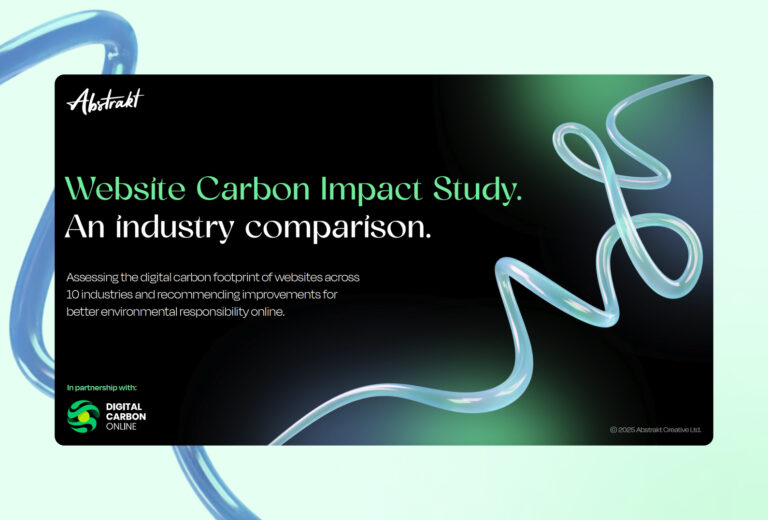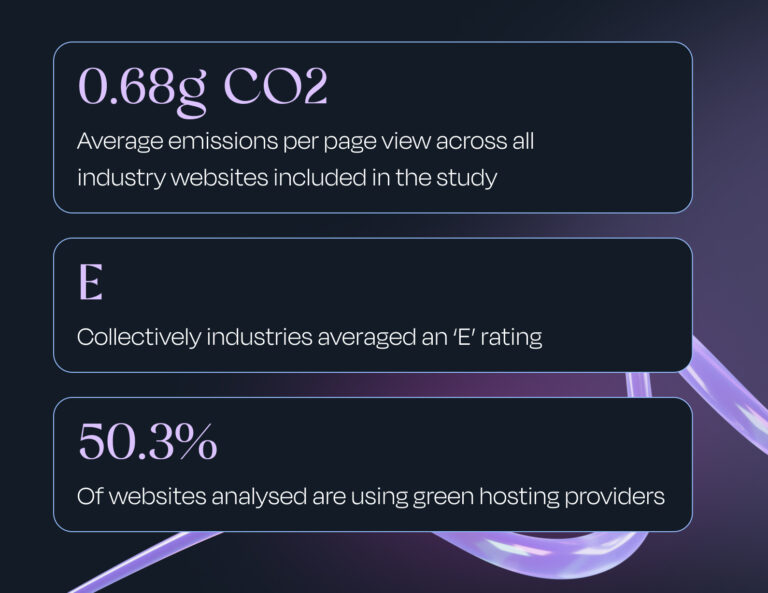Website carbon impact: how does your industry compare?
3 min read

As an agency and Certified B Corp, we see firsthand how sustainability goals and digital carbon awareness vary wildly across industries. Some are leading the way, others need more support. So, we dug in—who’s getting it right, and who has work to do?
At Abstrakt, we’ve carefully analysed the digital sustainability of websites across 10 industries. Our Website Carbon Impact Study compares the emissions of 300 businesses, highlighting where improvements are needed and who’s leading the way in creating a greener web.
This study looks into the performance of each industry, uncovering key observations and patterns that influence their website CO2 emissions.
Already eager to read it? Download it here.
Why we created this study
As businesses work to reduce their environmental impact, focusing on the often-overlooked digital carbon footprint of websites is becoming increasingly crucial. Some industries are embracing best practices, while others have a long way to go.
To get the data needed for this study, we partnered with Digital Carbon Online, a tool that provides a comprehensive view of website emissions. Their methodology helped us gather accurate insights into the carbon footprint of websites across industries, ensuring our findings are backed by real data.
We want to support understanding, share knowledge and offer actionable tips on how to lessen digital carbon footprints. This study is part of that mission.
Which industries are making progress? Who needs to step up?
Our study measured website carbon emissions, rating sites from A+ (very efficient) to F (high emissions). The findings were eye-opening:

The average emissions per page view across all industries was 0.68g CO2, earning a low E rating.
Insurance websites had the best average carbon rating (C) with an average 0.44g CO2 emissions per page view.
Food & beverage has the largest carbon emissions of all the industries included in the study with an average carbon rating of F.
50.3% of websites were hosted using green energy, with the construction industry leading the way (79.3% on green hosting).
Our data showed that eco brands—despite their sustainable focus—ranked second worst for digital carbon impact.
Some of the biggest eco brands with strong environmental commitments offline were surprisingly high-carbon online, proving that digital carbon footprints still aren’t on many corporate sustainability agendas.
Why this matters and what you can do
Every click, scroll and page load contributes to a website’s carbon footprint. By designing with sustainability in mind, businesses can reduce their digital emissions while also improving website speed, SEO, and user experience.
Our study shares actionable recommendations to help brands clean up their web presence, offering opportunities to reduce carbon footprints and enhance digital sustainability.
If you’re ready to take action, Abstrakt can help. We specialise in creating websites that are equally beautiful, performant, and carbon-conscious.
Get in touch to see how we can improve the impact of your website.

Lucy Williams
A Principal UX and Digital Designer with almost two decades of experience. She loves balancing UX thinking with digital creativity to design innovative & vibrant products.
She has specialist knowledge in digital brands and sustainability.
Connect on LinkedIn.
How to create a greener web with a sustainable website design
4 min read

Leave a green impression: be a sustainable brand online
4.5 min read

How to practice green SEO
6 min read
